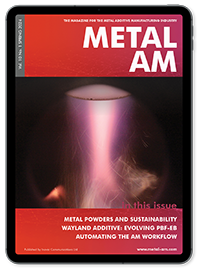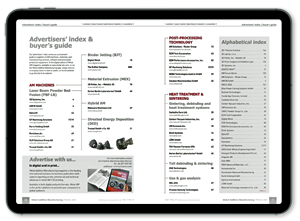Across the world, a new wave of aerospace engineers are designing and building the next generation of aero engines and systems around the revolutionary capabilities of Additive Manufacturing. Twenty years ago this was a vision, but today it is a reality. From fuel nozzles to Stage 5 and Stage 6 low pressure turbine (LPT) blades, housings to structural elements, in this article Metal AM magazine’s Technical Consultant Martin McMahon reviews the progress that has been made, shining a light on selected applications that offer insight to those in the aerospace industry who want to get up to speed with progress.
... Read more »
When it comes to presenting a review of the world’s largest international exhibition for AM, one can go about it in two ways: very broad generalisations about the state of the industry or a more focused review of a handful of noteworthy developments. Given the 859 exhibitors at Formnext 2023, spread over some 54,000 m2, this review by Dr Martin McMahon takes the latter approach, offering broader context where possible. Whilst many more press announcements are covered in the industry news section of this issue, the following report provides an overview of how – and where – AM is evolving and maturing into a credible and dynamic technology.
... Read more »
While the Norwegian market for Additive Manufacturing has long revolved around prototyping and polymer materials, metal Additive Manufacturing has seen rapid development in recent years. This is in large part thanks to the opportunities that the country’s oil and gas industry is now seeing in the technology. In this article, Joppe N Christensen considers why it has taken so long to get started with metal AM in Norway and introduces companies and individuals who are now leading the way.
... Read more »
Metal Additive Manufacturing is on a long journey, from the early technology concepts of several decades ago to its current usage in a relatively small number of markets with specific, highly-specialised application requirements. If the journey leads to the widespread adoption of metal AM technology by industry, can we ask, ‘Are we there yet?’ Dr Maximilian Munsch, Dr Eric Wycisk, and Matthias Schmidt-Lehr, from strategy consultancy and AM market analysis specialist AMPOWER, delve into the evolution, current status, and future prospects for the industry, seeking to uncover the true extent of its potential.
... Read more »
Dr Adrian Keppler has been an active participant in the AM industry for close on fifteen years. Based on his past experience as the Managing Director, and later CEO, of EOS GmbH, and his current role on the advisory boards of numerous AM startups, Keppler believes that more can, and should, be done to advance industrial applications of AM. Are the industry’s efforts to develop new technologies without perfecting and industrialising existing technologies holding it back? Should the less exciting work of industrialisation be prioritised over the next shiny technology release? Joseph Kowen interviews Keppler for Metal AM magazine.
... Read more »
General Atomics Aeronautical Systems, Inc. (GA-ASI) is the world leader in the design and manufacture of Unmanned Aircraft Systems (UAS). The company is no stranger to AM, with its Additive Design and Manufacturing Center of Excellence being integral to the qualification of more than 300 AM flight components and the installation of more than 10,000 AM parts on its aircraft. Now, it is working to identify and partner with some of the most innovative players in the industry in order to further leverage the capabilities of the technology. Divergent Technologies, the company behind Czinger Vehicles, is one such company. Jeff Kerns reports for Metal AM magazine.
... Read more »
A decade ago, the majority of commercial metal Additive Manufacturing machine, materials and application developments took place in Europe and North America. Today, the picture is very different and China in particular has become a leading global player. Clear national strategies, combined with a strong drive to leverage commercial opportunities, have resulted in a powerful and dynamic metal AM industry that is moving rapidly towards self-sufficiency. In this article, Xuesong Pan (Peter), co-founder of China’s 3D printing media company Nanjixiong, reports on recent developments.
... Read more »
Thanks to a new generation of compact metal Additive Manufacturing machines optimised for dental laboratories, combined with software improvements and optimised workflows, AM technology is now being more widely implemented in medium- to large-sized dental laboratories. In this article, Stijn Hanssen, Director, Dental Applications & Business Development, 3D Systems, reports on the application of metal AM technology for digital dentistry, reducing labour costs, maximising productivity and providing faster outcomes for patients.
... Read more »
Three years ago, Metal AM magazine published a widely read article on the use of Laser Beam Powder Bed Fusion (PBF-LB) technology for precious metal jewellery production. Today, the continuing rise of sinter-based AM technologies promises to open up the jewellery sector yet further, with new opportunities for both mass-market production as well as bespoke pieces. Chiara Armbruster, Sonja Kappler, Carlo Burkhardt, Gerald Mitteramskogler and Apollinaria Frydmann offer an overview of this new generation of solutions and the state of the technology. A number of application examples are also presented.
... Read more »
The development and communication of standards is vital to building customer confidence and trust in Additive Manufacturing, and it is only by building that trust that the industry can advance its adoption across a wider range of markets and applications. In this article, Khalid Rafi, ASTM International, and Shane Collins, Wohlers Associates, highlight the importance of standards, outline the standards development process, and explain why individuals employed within the AM industry should seek to involve themselves in this process. [First published in Metal AM Vol. 8 No. 3, Autumn 2022]
... Read more »
The importance of, and connections between, the arts and Additive Manufacturing can be unclear. For AM, the greatest challenge is managing and capitalising upon the growing awareness of its role in industry and its impact on society and daily life. Major public works, like the MX3D bridge in Amsterdam, do more to shift public perception of the possibilities AM offers, than any number of industrial successes. Elizabeth Henry, principal and founder of Henry General Strategies, explores the relationship between the world of the arts and the state of the AM industry, and ponders what benefits can be found when the two are brought together. [First published in Metal AM Vol. 8 No. 3, Autumn 2022]
... Read more »
As Additive Manufacturing sees growing use in a broader range of industries, researchers have been increasingly focused on expanding the types of material that can be processed via this technology, including the challenging field of refractory metals and hard materials. The AM research featured in the programme of the recently held Plansee Seminar represents the cutting edge of what is possible with these materials using the most advanced manufacturing processes. Here, Bernard North collates the seminar’s takeaways on the suitability of these materials for direct Additive Manufacturing processes. [First published in Metal AM Vol. 8 No. 3, Autumn 2022]
... Read more »





Join our community